I Played Every Single Tomb Raider Game So You Don’t Have To – Part 1
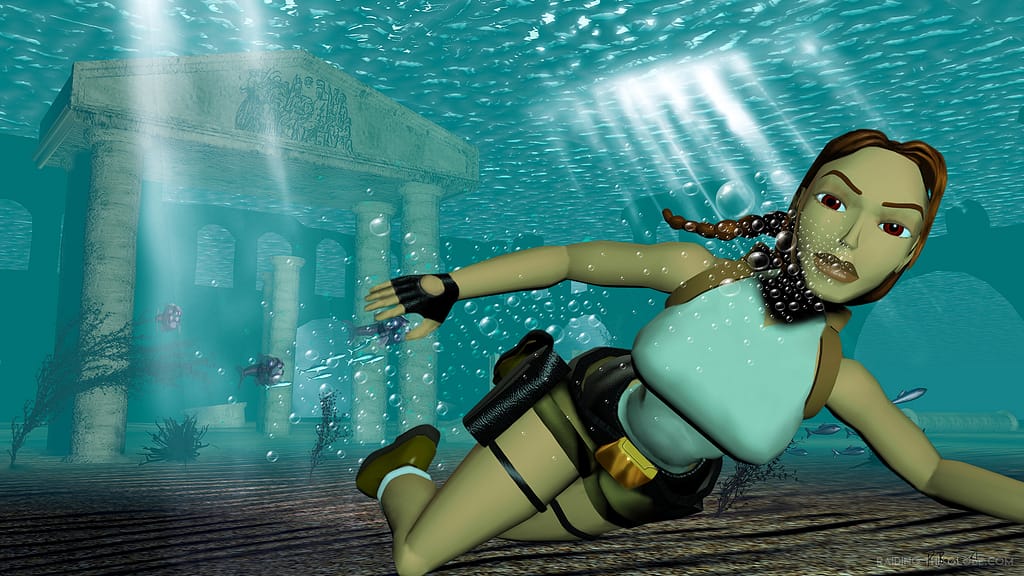
On the 12th of June, 2022, I published an article titled “How I Stopped Worrying and Learned to Love the Switch”, about the love/hate relationship I had developed with Nintendo’s hybrid console over the years since its release. My feelings towards it had changed quite dramatically at the time; Primarily due to a week-long stay in hospital with only my Switch to keep me company. As I wrote the article, I felt I was finally starting to rally around from the extremely invasive surgery that I had undergone, and was just about ready to get back in the saddle and start prioritising writing articles once again…
Or so I thought.
In the weeks that followed, I experienced a vast amount of minor complications and negative side effects throughout my recovery, which lead to me feeling completely demotivated. Severe fatigue, aches, pains, cramping, bleeding, insomnia, hypersomnia, post-operative depression, and general exhaustion… Suffice to say that if there was an unpleasant symptom: I most likely experienced it at one point or another. As an unfortunate result, I didn’t feel particularly capable of writing again for quite some time.
I found myself in desperate need of some long-winded yet simplistic experiences that could keep me grounded for the remainder of my lengthy recovery. Some video games were helping a significant amount, whilst others were simply too hard to focus on. I’d binged through a few different TV shows to keep myself occupied, but I was reaching the point where I honestly couldn’t bare to get blind-sided by another show’s cancellation, right after seeing its cliffhanger ending. I’d tried reading a number of books and novels at the time too, but the brain fog that accompanied a lot of my early symptoms made it very hard to process any substantial pieces of written information.
Through luck and luck alone, it was then that I spotted an outrageously good deal on the popular gaming storefront Green Man Gaming. Between the discounts from their newly started Summer sale, and the additional price-cuts granted to me by my Gold Membership status; I could purchase all six games in the original Tomb Raider series for a grand total of £3.24. I leapt at the opportunity and finally had a way to take my mind off of my medical struggles. This was a series simplistic enough to immerse myself in, yet lengthy enough that it could grant me some sense of normalcy as I played through it, day after day. Better yet: This was a series of games that I had scarcely ever touched before.
About three months later, I had already finished playing —from beginning to end— every single Tomb Raider game that had ever been released… That includes all three games in the original trilogy, the prequel and sequel combo of 4 & 5, the infamous Angel of Darkness title, Crystal Dynamics’ Legends trilogy and even the most recently released Survivor trilogy, alongside every spin-off I could get my hands on.
Was it a tad excessive? Perhaps. But was it enjoyable? Absolutely!
I’ve since made several major strides in my recovery and have returned to writing on a regular basis, yet I still find myself thinking back to each of Lara’s adventures and how much they helped me endure that strenuous uphill battle. As such, (whilst they’re still so fresh in my memory), I’d like to take you on a journey through each title in the Tomb Raider franchise, speaking about their positives and negatives and letting you know which ones may be worth revisiting after all this time!
Alongside a general spoiler warning, please note that I played each of these games on Steam rather than their original consoles or through the process of emulation. As such, many of the early titles required a lot of patching and fixing before they could run properly, so please be aware that you may need to consult some set-up guides if you intend to play them, too. Without further ado: Let’s get started from where it all began!
Tomb Raider (1996)
Time Played: 12 hours, 59 minutes
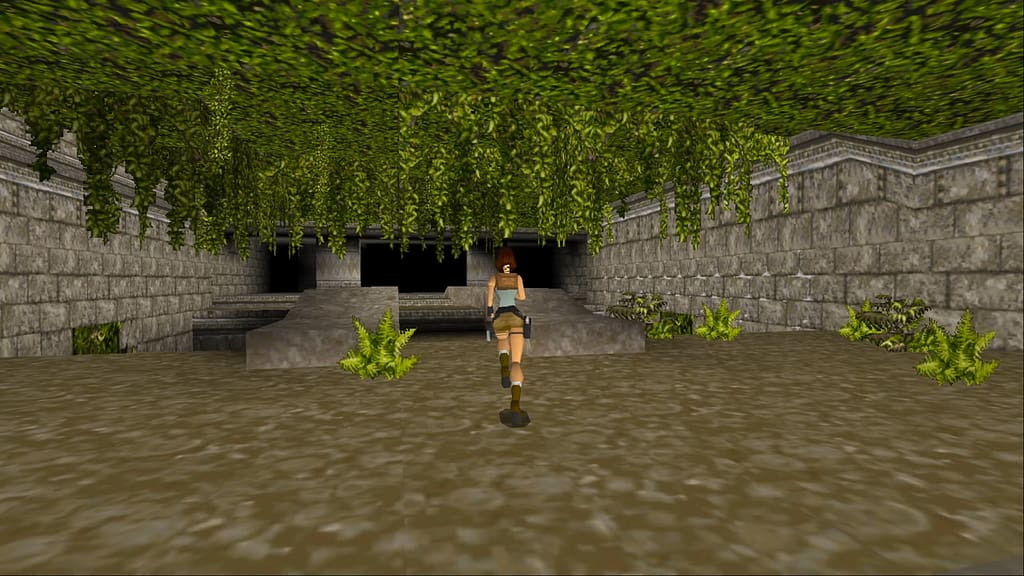
Originally released for the Sega ****** in 1996, this is where the Tomb Raider franchise first got started. It offers a surprisingly in-depth story for a game of its era, following in the footsteps of the professional archaeologist: Lara Croft. At the behest of world-famous CEO Jacqueline Natla, Lara has agreed to search for the Scion of Atlantis, a mysterious artefact rumoured to be the power source of the long lost city itself. Lara’s search takes her on a grand-scale adventure to Peru, Greece, and Egypt, and pits her against several memorable antagonists along the way, such as Natla’s head henchman Pierre Dupont, and mercenary for hire Larson Conway.
Though the story is told quite sporadically throughout the game’s 13-hour-long campaign, it’s a rather detailed and very satisfying affair. This is solidified even further by Tomb Raider 1’s unique take on Atlantis and its surprisingly high-quality voice acting; Now considered to have been something of a rarity in titles from the 1990s. By the end point I was genuinely impressed by how well TR1 had held up in terms of narrative, and was eager to see where the story would go next.
Gameplay, however, is every bit as important as the story when it comes to a good Tomb Raider game, so it’s also worth noting that TR1 still plays very well. It utilizes tank controls for environmental navigation with auto lock-on gunplay for combat scenarios. Movement can feel a little bit slippery when it comes to the more pinpoint accurate platforming sections, but you can circumvent these difficulties thanks to the precision of the walk button, and Lara’s ability to perform jumps from a completely stationary position. Thankfully, every section of the game is built with Tomb Raider’s specific control scheme in mind, giving you plenty of room to accommodate for the somewhat outdated way that Lara moves, whilst always making it clear when you can and cannot reach an area.
Combat only occurs in rooms that have plenty of space for easy-input somersaults and quick-turn dodge rolls, meaning it’s never difficult to keep your enemies in front of you, despite the fact that tank controls don’t usually suit such fast-paced combat situations. Whether you’re fighting with Lara’s signature dual pistols, her shotgun, dual magnums, or even dual uzis —all of which are easy to swap between thanks to TR1’s clearly designed inventory system— you’ll find that the game feels consistently good to play on account of how simple and tightly designed each mechanic is.
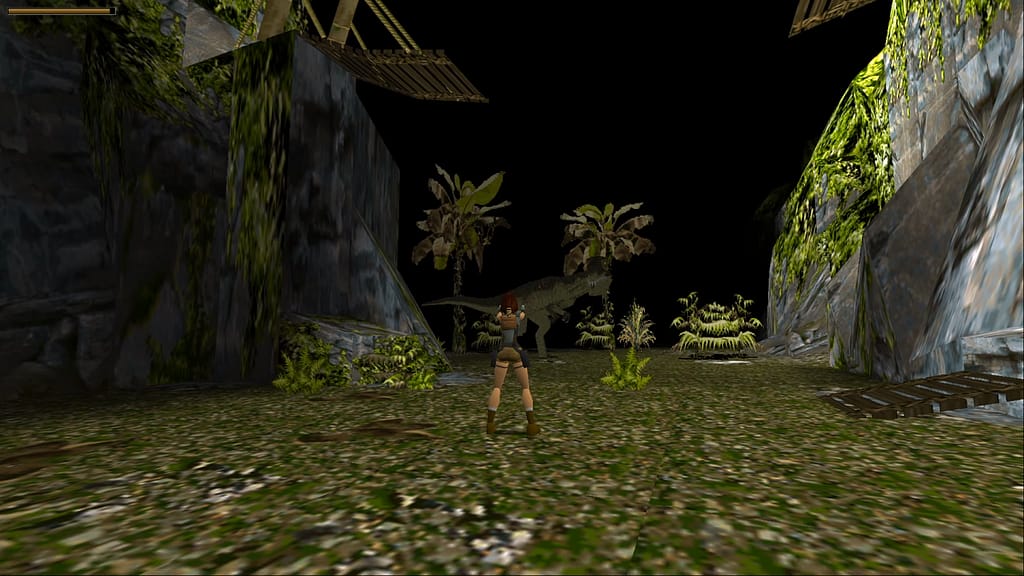
Unfortunately, that’s not to say that there aren’t any finicky aspects to the game. There are plenty of things that annoyed me throughout the experience, including switches that require pixel-perfect positioning before they can be used, ledges that take forever to crawl along, and boxes that are dragged so slowly, square by square, that they’ll be sure to wear down your patience way before you’ve reached your destination.
Not to mention the game’s not-so-great framerate, which cannot be uncapped without breaking large portions of the game. This causes running jumps and sharp turns to feel a lot more sluggish than you’d expect, and can make backtracking feel like a nightmare. They’re minor issues and are certainly to be expected considering the game’s age, but since there are so few gameplay mechanics throughout the adventure, you’re guaranteed to encounter these problems on an extremely regular basis…
Tomb Raider 1’s biggest problem, however, (which definitely detracted from my experience with it), is its level design. It reminds me of the old adage of having “too much of a good thing.” The first 4 levels in Peru are all excellent, lasting about 10 to 15 minutes each as they cover fun platforming sections, enjoyable puzzles, a couple of underwater areas, and a handful of combat encounters. After that though, each level becomes both longer and less varied, starting at 30-minute levels and ending with some truly overwhelming zones that take upwards of an hour to beat.
Because of these level lengths, each area must become more grand in scale, yet there are points where it gets so complex —with many puzzles intertwining with one another— that the experience starts to drag. There’s also very little direction given throughout these longer levels, which made me feel like I was making zero progress at times throughout the latter half of the game. Perhaps dividing TR1’s existing areas into a larger number of small-scale levels would’ve made it easier to explore and differentiate between its puzzles. Whilst I’m sure this would’ve ultimately made the game’s pacing better too, it was sadly not meant to be… The campaign simply doesn’t have enough content variety to remain interesting from start to finish, when so many lengthy levels stand in your way.
Regardless, the first Tomb Raider game is a good and enjoyable experience, all in all. The dated visuals provide some nice graphical nostalgia without looking actively bad, the story is of a much higher quality than you’d expect, the combat is simplistic and easy to engage with, and the platforming is tightly designed even if the framerate and precision can work against you at times. I’d definitely recommend this one, if only to see where it all started, oh so long ago.
Tomb Raider: 7.0 / 10
Tomb Raider II (1997)
Time Played: 16 hours, 48 minutes
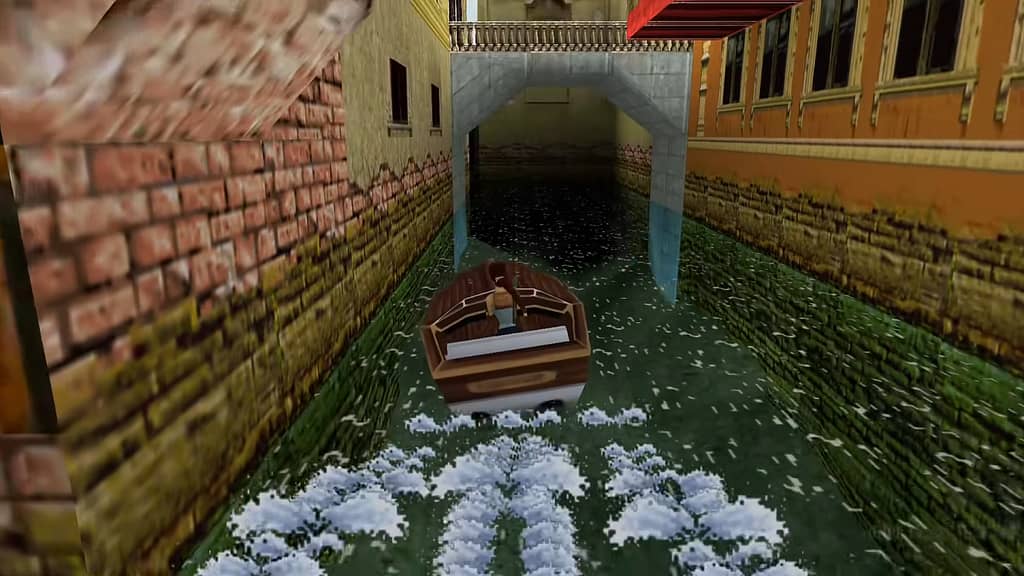
Merely a year later, the second Tomb Raider game was released. This one wowed me right from the start, thanks to just how much of an evolution it is over the original. It’s a deeply impressive example of just how much a series can evolve over the course of a single year’s turnover, and is reminiscent of the much more modern example of the Assassin’s Creed series, which saw a monumental upgrade from its first game through to its second.
The first notable upgrade is in the visuals, which have seen a huge increase in polygon count, asset detail, texture resolution and overall style. The framerate also saw an increase to a stable 30fps, therefore making my few complaints about the first game’s somewhat sluggish movement completely null and void. An indie game could come out looking pretty much the same as TR2 today for the sake of low poly nostalgia value, and I honestly wouldn’t bat an eyelid.
It’s also pretty impressive just how much is added by having a few new animations and controls. Being able to do a 180-degree turn in mid-air makes combat way better, whilst being able to do the same in water allows for way more in-depth underwater levels. Ladders, climbable walls, and zip lines make traversal far more varied and immersive this time around, whilst TR2’s introduction of dynamic lighting and flares adds a lot to both the graphical fidelity and the game’s atmosphere. It honestly feels like the environment is something to be actively interacted with and explored now, rather than just being a backdrop for any given encounter or puzzle, which is how it felt in the original.
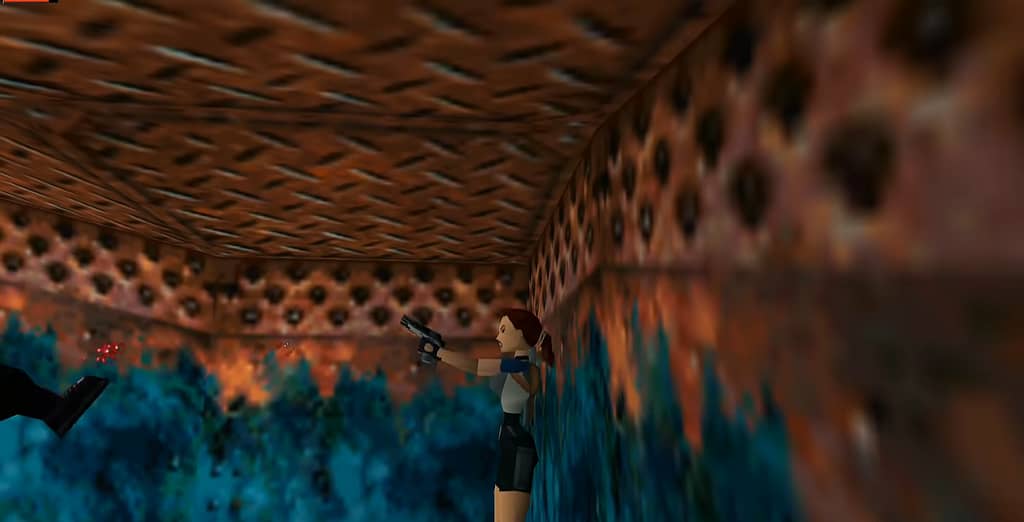
Having a wider variety of weapons is a nice touch too. This time around: All four of the original weapons return, but with several new additions in the form of automatic pistols, an M16 assault rifle, a grenade launcher, and even a harpoon gun, used to introduce underwater combat to the series. These, plus the addition of motorboat and snowmobile vehicle sections, gives the gameplay far more variety than the original game could ever hope to achieve.
The biggest improvement by a significant margin is the level variety. Whilst TR1 took Lara to a number of different locales; Tombs do tend to look quite similar to one another after a while, be they grassy, sandy, or made from stone. TR2 steps up the variety with a wide array of locations, including the Great Wall of China, the canals of Venice, a colossal sunken cargo ship, a Tibetan monastery, and even more. As a bonus: All of these areas have completely unique texture tile sets, meaning you never get tired of the overall look of the game.
But TR2 certainly isn’t without its downsides, with its story being the biggest. Here, a mysterious gang are trying to claim an ancient Chinese dagger that allegedly allows its owner to transform into a dragon. Lara finds the door that seals this dagger away within the very first level, then spends roughly 80% of the game traversing the world in search of the door’s key, without any further story progression whatsoever. There are only about 10 lines of dialogue spoken here in total, and most FMV cutscenes are used to showcase some cinematic action rather than add to the story, which is a real shame after the depth of the first game’s narrative…
Thanks to all of its technological and mechanical improvements, I’d definitely say that Tomb Raider II is a better game than its predecessor. But its story, pacing, and still excessively long and complex levels, (with the game clocking in at roughly 18 hours this time around), definitely hold it back. I can’t help but feel that if the story was a little more fleshed out, then perhaps the pacing would be fixed as well, with the extreme length serving more of a purpose… But, you can’t win them all. I’d recommend this title if you’re purely interested in a good gameplay experience, otherwise, its quite easily skipped due to its lack of narrative focus.
Tomb Raider II – 7.5 / 10
Tomb Raider III: Adventures of Lara Croft (1998)
Time Played: 19 hours, 13 minutes
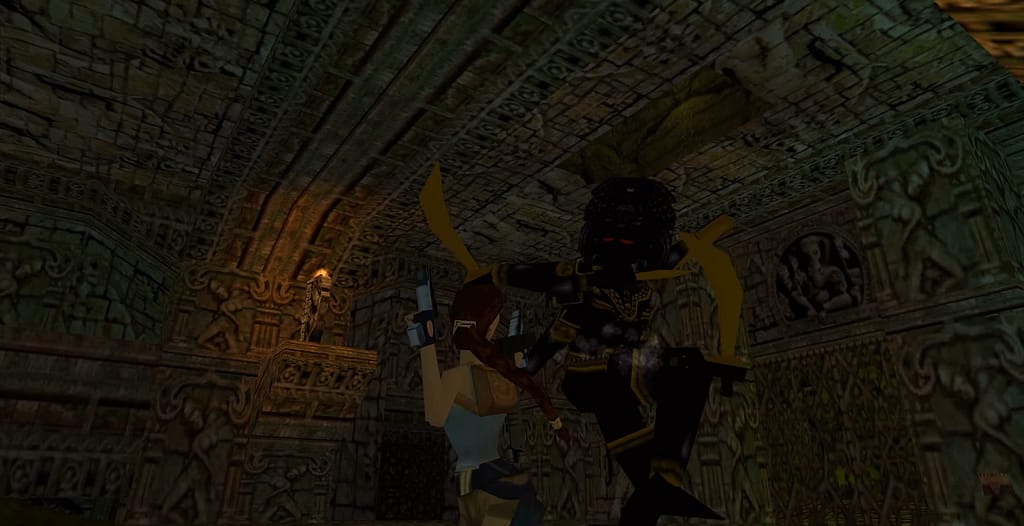
Another year passes and another Tomb Raider game gets released. Whilst the title “Adventures of Lara Croft” makes this sound like an anthology game: It’s not. It’s a straightforward third entry in the series that just happens to have an unusual name.
This time around, it’s about a meteorite that struck Antarctica millions of years ago, which a corporation called RX Tech have recently rediscovered. Lara is on a general treasure hunt for a famous Indian artefact known as the Inafuda Stone when she crosses paths with an RX Tech researcher. He reveals that the Inafuda Stone is just one of four ancient artefacts that were carved from the Antarctica meteorite, which is alleged to have mysterious powers. Thus begins a race against time for Lara to collect them all before RX Tech can use them for evil.
Honestly, the story is a huge improvement after TR2. Pretty much every single level features at least one cutscene that furthers the story, and Lara’s personality is more fleshed out than ever before. This adventure also takes you to a lot of interesting new environments such as a ruined temple in an Indian jungle, the Area 51 site in the Nevada desert, the rooftops and underground of late 90s London, a coastal village in the South Pacific, and of course, Antarctica itself. TR3 always manages to feel interesting and fresh, with each locale varying up the story beats quite dramatically. It ultimately feels like a true successor to the first game, as it never throws its story to the sidelines in the way that TR2 often did.
But let’s talk gameplay, because this game is hard as nails! Poison rapidly consumes your medpacks, a new ‘freezing’ mechanic prevents you from staying in cold water for too long, ammo is extremely sparse, and traps are constantly jumping out at you and encouraging a trial-and-error playstyle. To make matters worse: Enemies are more damaging than ever, and every room feels like a puzzle even when there are no puzzle mechanics at play, simply due to the complexities of how each area is designed…
Most significantly of all: Almost every weapon besides the starting pistols can only be found in secret areas, meaning that thorough exploration is more essential than ever before. It’s a huge difficulty spike compared to TR1 or TR2 —which isn’t necessarily a bad thing— but it does make some sections a little more frustrating than they otherwise would be throughout the 19-hour-long campaign.
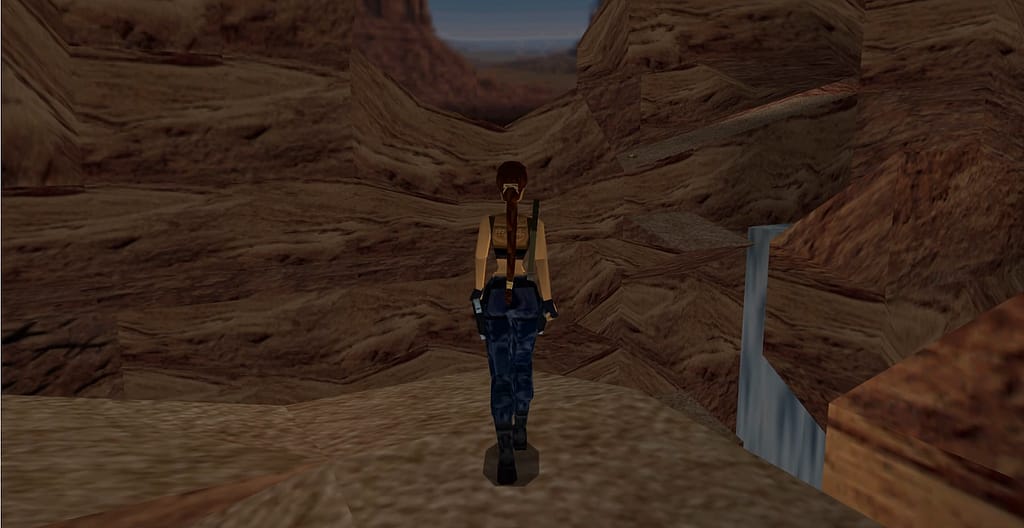
Thankfully there are lots of superb gameplay improvements here too, which alleviate some of these difficulties. Lara’s turning circle is way tighter here; her jumps feel smoother and climbing feels a little faster too. The pinpoint precision restrictions of pulling levers and picking up items have finally been removed, which is a very nice quality-of-life improvement. Plus, the addition of a world map, which allows you to choose which order you hunt down the artefacts, ends up making each story beat and level flow in a much more personalized way.
This time around, the newly introduced mechanics include being able to hang from certain ceiling materials and being able to crouch and crawl for the first time in the series. Being able to hang from ceilings doesn’t amount to much, as this mechanic isn’t utilized very often, but being able to crouch and crawl is a real game-changer and an excellent addition all around! Crawling allows outdoor environments to feel more natural on the whole and far less blocky, as each level is now designed with both upper and lower traversal in mind. These mechanics may not sound like much when so little is added in each sequel, but they’re definitely starting to make a significant difference to the formula, one game at a time.
Weapon-wise, however, TR3 is a bit of a disappointment. Whilst combat feels better than ever —particularly due to the huge variety of enemies in this installment— the new weapons all come with a significant downside. Though the newly introduced desert eagle, MP5 SMG, and rocket launcher all feel satisfying to fire, their introduction has replaced two of TR2’s far more enjoyable weapons: The automatic pistols and the M16 assault rifle. I would’ve much preferred it if the series’ arsenal just kept getting bigger and better, but unfortunately, it wasn’t meant to be… Throw in the fact that one mission in particular strips you of all your equipment, and you’ll definitely find yourself getting quite frustrated with TR3’s weapon selection as the game goes on.
Thankfully, one final positive to weigh against TR3’s arsenal is its nice selection of vehicles. TR2’s snowmobile and motorboat were fun, but they had entire levels designed around them, meaning they often overstayed their welcome. In TR3 however, you have access to a quad bike, a kayak, an underwater propulsion vehicle, a dingy, and a mine cart. There’s a very nice amount of variety here for sure, and by making vehicles play smaller and less frequent roles throughout the campaign: They never end up dragging on for too long. This is a huge point in the game’s favour over TR2.
All in all I’d say that TR3 is probably the best game in the original trilogy, thanks to both its gameplay and its story. Unfortunately, a few issues here and there definitely hold it back from perfection… If you’re a glutton for punishment or are simply prepared to face a lot of trial and error, then look no further than Tomb Raider III; An excellent example of both action and adventure in the PlayStation 1 era.
Tomb Raider III: Adventures of Lara Croft – 7.8 / 10
Conclusion

That just about wraps it up for the original trilogy, but these first three games were just the tip of the iceberg. By this point, Lara Croft had become a significant 90s icon, who was instantly recognisable even to people who had never played the games before. So it wasn’t exactly surprising when —not long afterward— her fame began seeping beyond the borders of gaming, and out into popular culture.
By 1999, Lara was appearing in television adverts for cars sold by Volkswagen subsidiary SEAT’, alongside starring as the main mascot for the energy drink Lucozade, which she would continue to advertise until 2002. Whilst all this was getting started, negotiations began for two live-action films with Angelina Jolie starring as Lara Croft herself, which were released in 2001 and 2003, respectively.
All this is to say that Tomb Raider was huge, and Lara Croft had become even bigger than the confines of her own games. As the popular 90s saying goes: “Men wanted her, and women wanted to be her.” Unfortunately, it’s not entirely clear what non-binary folk wanted out of the situation, as 90s media was still trying its best to pretend that non-binary people didn’t exist! Regardless, the Tomb Raider franchise had a bright future ahead of it, with many more games to come.
But how were they, I hear you ask? Well, you can find out in the next part, coming very soon.
Thanks for reading!